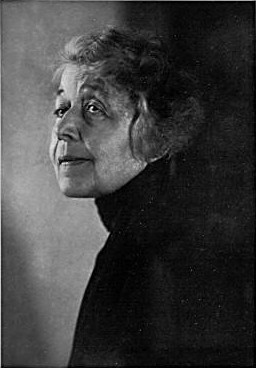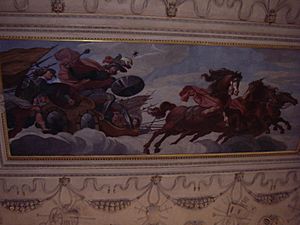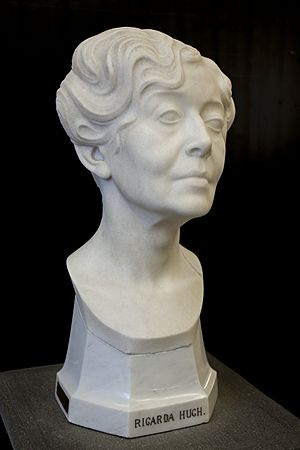Ricarda Huch facts for kids
Quick facts for kids
Ricarda Huch
|
|
|---|---|

Ricarda Huch by Wanda von Debschitz-Kunowski
|
|
| Born | 18 July 1864 Braunschweig |
| Died | 17 November 1947 |
| Education | Doctor of Philosophy |
| Occupation | Writer |
| Awards |
|
Ricarda Huch (German: [huχ]; 18 July 1864 – 17 November 1947) was an important German writer and thinker. She trained as a historian and wrote many books about European history. She also wrote novels, poems, and a play. An Asteroid called 879 Ricarda is named after her. She was nominated for the Nobel Prize in Literature seven times.
Contents
Ricarda Huch's Early Life and Schooling
Ricarda Huch was born in Braunschweig, Germany, in 1864. Her family, the Huchs, were wealthy merchants. Her brother Rudolf and cousins Friedrich and Felix also became writers.
In 1887, Huch moved to Zurich because German universities did not allow women to get degrees. She took entrance exams for the University of Zurich. In 1892, she earned her doctorate degree in history. Her main project was about "The neutrality of the Confederation during the Spanish War of Succession." While studying, she made lifelong friends with Marie Baum, Hedwig Bleuler-Waser, and Marianne Plehn.
After getting her degree, she worked at the Zurich public library. In 1896, she taught at a girls' school in Bremen.
First Books and History Studies
In the 1890s, Ricarda Huch started publishing her first poems and stories. Her first novel, Erinnerungen von Ludolf Ursleu dem Jüngeren, came out in 1892. In 1897, Huch moved to Vienna to study Romanticism. There, she met Ermanno Ceconi, an Italian dentist, and they married in 1898. Their daughter, Marietta, was born in 1899.
In 1899, the first part of her two-book study on German Romanticism was published. This book, Blütezeit der Romantik, made Huch famous as a historian. The second part, Ausbreitung und Verfall der Romantik, came out in 1902. Huch believed that German Romanticism had a time of growth and a time of decline. She thought that early Romanticism focused on balancing reason and fantasy. Later Romanticism, she felt, became too simple and focused on folklore and myth.
Some historians at the time found her work unusual. They were used to history being about big events and famous men. But Huch focused on describing the feelings and ideas of a historical period. She also wrote about the lives of ordinary people, like monks and children.
Huch and her husband moved to Trieste and then to Munich. They divorced in the early 1900s, but Huch and Ceconi remained friends. In 1903, her novel Vita somnium breve was published. In 1906, she wrote about Gottfried Keller and the Italian hero Giuseppe Garibaldi. In 1907, she published a book of poetry. That same year, Huch married her cousin, Richard Huch. In 1908, she published a book about the Italian unification movement, called Aus dem Zeitalter des Risorgimento.
Writings During World War I
In 1914, Ricarda Huch turned 50. Her three-book series about the Thirty Years' War had just been finished. This series made her one of Germany's most important historians. During the first years of World War I, Huch lived in Munich. In 1915, she published a study of Albrecht von Wallenstein, a famous general. She wrote about his efforts to unite Germany. After World War I, her ideas about renewing Germany through change became popular among German nationalists.
In 1916, she moved to Switzerland, but returned to Munich in 1918. During the war, she also published Natur und Geist (1914) and Luthers Glaube (1916). After the war, she published Der Sinn der heiligen Schrift (1919). Huch believed in a Lutheran faith combined with a broad view of history. She saw Martin Luther as a man of great faith. Huch valued individuality and believed that change was always happening.
Writings During the Weimar Republic
In the early years of the Weimarer Republik (the German government after WWI), Huch published Entpersönlichung in 1921. In 1924, she wrote about the anarchist Michael Bakunin. Her study of the Prussian reformer Heinrich Friedrich Karl vom und zum Stein came out in 1925. In 1927, she published three books of essays about German cities, called Im alten Reich. Lebensbilder deutscher Städte. In these essays, she described old cities, their buildings, and important historical events. Huch highlighted the unique spirit of each city and the strong community feeling they created.
In 1927, Huch, her daughter, and her son-in-law Franz Böhm moved to Berlin. In 1931, Huch received the Goethe Prize. She was the first woman invited to join the Preußische Akademie der Künste (Prussian Academy of Arts). In 1930, her book about the German revolutions of 1848–49 was published.
Standing Up to the Nazis
When the Nazis came to power in 1933, Ricarda Huch bravely resigned from the Prussian Academy of Arts. She did this to protest their actions. The academy asked its members to sign a statement of loyalty to the new government. Huch refused. She wrote letters to the academy's president, stating that she would not give up her right to freedom of expression. She openly disagreed with the Nazi ideas and their harsh methods.
Huch stayed in Berlin and researched early German history. In 1934, she published the first part of her three-book series on medieval German history. She wrote about medieval political, social, and religious groups. Her views were a clear challenge to the Nazi ideas about German culture and its origins.
Her son-in-law, Franz Böhm, lost his job because of the Nazis. In 1936, Huch, her daughter, Böhm, and their son moved to Jena. Böhm got a teaching job at Jena University. But in 1937, Huch and Böhm were accused of speaking out against the government. This happened because they had defended Jewish people at a dinner party. Even though they were not convicted, Böhm lost his teaching position. During World War II, Böhm moved to Freiburg and then to Frankfurt, while Huch and her daughter stayed in Jena.
Post-War Work and Legacy
After the war, when Jena was going to be part of the Soviet zone of occupation, Huch fled to West Germany. She settled in Frankfurt. She started working on a book to honor members of the German resistance to Nazism. In 1946, she asked for help from the public to gather information about those who had died resisting the Nazis. She believed their sacrifice helped all Germans keep their human dignity during a very brutal time.
Ricarda Huch was the honorary president of the 1947 German Writers' Congress in Frankfurt. She died in November 1947 at the age of 83. Her book about the German resistance was not finished.
Historians like Professor Frank Trommler say that Huch, along with other writers, bravely stood up for freedom and against tyranny during the Nazi era. They helped shape Germany's changes after the Nazis fell. These writers were watched closely by the Nazis because many Germans read their books.
Ricarda Huch was in her 70s when the Nazis took power. Unlike some writers who left Germany, she stayed and openly opposed the Nazi ideas from the start. She continued to live in Germany and published her books through Swiss publishers. After World War II, the famous writer Thomas Mann called Huch "the first lady of German letters."
Publications by Huch
- Gedichte Dresden 1891
- Evoe Berlin 1892
- Erinnerungen von Ludolf Ursleu dem Jüngeren Berlin 1893
- Gedichte Leipzig 1894
- Der Mondreigen von Schlaraffis Leipzig 1896
- Teufeleien, Lügenmärchen Leipzig 1897
- Haduvig im Kreuzgang Leipzig 1897
- Fra Celeste und andere Erzählungen Hermann Haessel Verlag, Leipzig 1899
- Blütezeit der Romantik Leipzig 1899
- Ausbreitung und Verfall der Romantik Leipzig 1902
- Dornröschen. Ein Märchenspiel Leipzig 1902
- Aus der Triumphgasse. Lebensskizzen Leipzig 1902
- Vita somnium breve Insel Verlag, Leipzig 1903
- Von den Königen und der Krone Stuttgart 1904
- Gottfried Keller Schuster & Loeffler, Berlin und Leipzig 1904
- Seifenblasen. Drei scherzhafte Erzählungen Stuttgart 1905
- Die Geschichten von Garibaldi (Volume 1: ‘’Die Verteidigung Roms’’; Volume 2: ‘’Der Kampf um Rom’’) Stuttgart/Leipzig 1906–1907
- Neue Gedichte Leipzig 1908
- Menschen und Schicksale aus dem Risorgimento Leipzig 1908
- Das Leben des Grafen Federigo Confalonieri Leipzig 1910
- Der Hahn von Quakenbrück und andere Novellen Berlin 1910
- Der letzte Sommer Stuttgart 1910
- Der große Krieg in Deutschland Leipzig 1912–1914 (later as: Der Dreißigjährige Krieg Leipzig 1929)
- Natur und Geist als die Wurzeln des Lebens und der Kunst München 1914 (new edition: Vom Wesen des Menschen. Natur und Geist Prien 1922)
- Wallenstein. Eine Charakterstudie Leipzig 1915
- Luthers Glaube. Briefe an einen Freund Leipzig 1916
- Der Fall Deruga Berlin 1917
- Der Sinn der Heiligen Schrift Leipzig 1919
- Alte und neue Gedichte Leipzig 1920
- Entpersönlichung Leipzig 1921
- Michael Bakunin und die Anarchie Leipzig 1923
- Stein Wien / Leipzig 1925
- Teufeleien und andere Erzählungen Haessel, Leipzig 1924
- Graf Mark und die Prinzessin von Nassau-Usingen’’ Leipzig 1924
- Der wiederkehrende Christus. Eine groteske Erzählung Leipzig 1926
- Im alten Reich. Lebensbilder deutscher Städte (3 Volumes: Der Norden/Die Mitte des Reiches/Der Süden) 1927
- Neue Städtebilder Im alten Reich’’ Leipzig 1929
- Gesammelte Gedichte 1929
- Lebensbilder mecklenburgischer Städte 1930/1931
- Die Hugenottin Bern 1932
- Alte und neue Götter (1848) Die Revolution des 19. Jahrhunderts in Deutschland Berlin und Zürich 1930 (later as: 1848 Die Revolution des 19. Jahrhunderts in Deutschland 1948)
- Deutsche Geschichte 1934–49
- Römisches Reich Deutscher Nation Berlin 1934
- Das Zeitalter der Glaubensspaltung Zürich 1937
- Untergang des Römischen Reiches Deutscher Nation Zürich 1949
- Frühling in der Schweiz Zürich 1938
- Weiße Nächte Zürich 1943
- Herbstfeuer Insel, Leipzig 1944
- Mein Tagebuch Weimar 1946
- Urphänomene Zürich 1946
- Der falsche Großvater Insel, Wiesbaden 1947
- Der lautlose Aufstand. Bericht über die Widerstandsbewegung des deutschen Volkes 1933 - 1945 Edited by Günther Weisenborn, Rowohlt Verlag, Hamburg 1953
Images for kids
See also
 In Spanish: Ricarda Huch para niños
In Spanish: Ricarda Huch para niños





